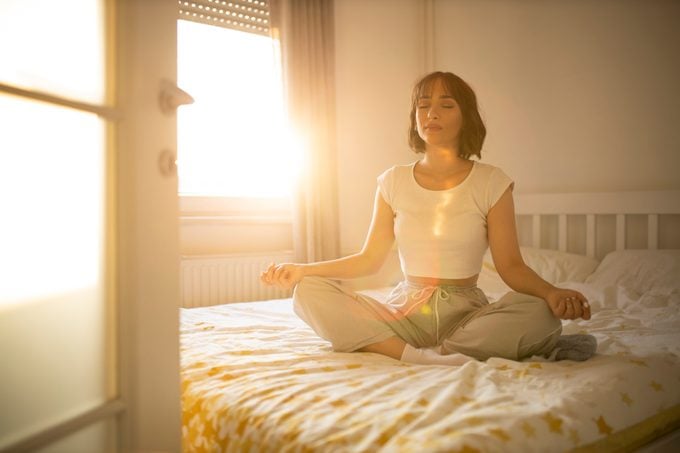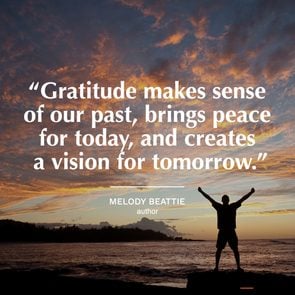What Is Gratitude Meditation, and How Can It Help?
Updated: Mar. 07, 2022
Practicing regular gratitude can benefit your overall health and emotional well-being. Here's why it's important, and how gratitude meditation could improve your life.
What is gratitude?
Gratitude means appreciating what is valuable and meaningful to you. It’s the opposite of entitlement, which refers to a belief that you have earned or are owed good things.
Psychologist and author Karen Lynn Cassiday says the key to “practicing gratitude” is learning to recognize when you’ve been blessed with something positive.
“Gratitude is the sense that others, the universe, or a higher power have granted you something good—and you are fortunate to have received that blessing,” says Cassiday, the clinical director of the Anxiety Treatment Center of Greater Chicago.

The science of gratitude
Gratitude has been studied in a variety of ways over many decades. Cassiday points to more than 15,000 research studies on the topic, with results mainly demonstrating the emotional and mental health benefits of gratitude.
In 2019, a team of researchers from the Netherlands took a novel approach by revisiting other gratitude studies from the previous decade, but this time focusing on physical benefits. While the research supported previous findings that gratitude leads primarily to mental and emotional well-being, the impact on overall body health was also evident.
That makes sense, Cassiday notes. Gratitude can lead the body to release dopamine—known as the “feel good” hormone—as well as oxytocin, a hormone that promotes bonding with others.
“Gratitude protects against negative emotions, such as depression and anger, and against toxic emotions, such as entitlement, resentment, revenge, cynicism, and hatred,” she says.
In a nutshell, gratitude is the “mother skill” that leads to resilience, grit, hope, and healthy relationships.
Gratitude is more than kindness
Kindness is an external action. It’s what you do or say to others. Gratitude is a reaction to something felt internally, that may or may not be shared with others.
“I believe experiencing gratitude is much more meaningful than parroting gratitude from a place of obligation or seasonal reminders,” says Laura Morse, a licensed psychotherapist in Atlanta.
Telling yourself that other people have it worse will likely not make you feel better, she adds. But keeping situations in perspective may help the balance.
“When more attention and validation is given to the negative aspects of our lives or situations, then hopelessness follows,” Morse cautions.
Simple steps to gratitude
The first step to living a life of gratitude is appreciation for the people, situations, or experiences that surround you.
“Showing gratitude does not have to be costly,” Morse says. ” Words of affirmation and acts of service can go a long way.”
Ways to incorporate more gratitude in your life include keeping a gratitude journal to write down your thoughts, goals, and experiences. Or you can write a gratitude letter to yourself or to someone else expressing your thoughts and feelings.
Cassiday encourages a 30-day challenge to notice three things each day for which you are grateful. Write down how that experience affected you, and what blessing you found in that moment.
For example, she says, you may write something like, “I am so grateful for the lovely colors of the fall leaves, especially the bright reds, and how it makes a gray time of the year beautiful and fascinating. I am blessed to be able to experience this.”
Practice gratitude daily
Gratitude should evolve like breathing—something necessary and natural. As you begin to live your life with an awareness of gratitude, it becomes less a “check mark” activity, and more your everyday essence in action.
“As we experience positive emotions such as gratitude, loving, kindness, and compassion, our awareness broadens,” said Kathi Kemper, MD, executive director of the Ohio State University College of Medicine’s Center for Integrative Health and Wellness. “Our creativity and problem-solving capacities blossom, and we become more effective in whatever we choose to do.”
It’s almost impossible to feel anxious and grateful at the same time, Dr. Kemper says. So when you start to notice your mind wandering toward worry, adjust your lens.
“Switch to focusing on people, circumstances, or things for which you are grateful, and watch your mood improve,” Dr. Kemper says. “It’s also a great practice before falling asleep each night.”

Blending gratitude and meditation
Similar to the goals of gratitude, meditation is a mental exercise to increase awareness of the present moment.
“All meditation really is, is redirected attention,” explains Anne Hartley, founder of Hart Life Academy in Australia, which trains and certifies life coaches. “Instead of allowing the mind to wander and think of anything, meditation brings the mind’s attention to our breath, an object, or a mantra.”
Traditional meditation focuses on breathing and a repeated mantra—a sound, word, or phrase. The process can be adapted to a focus on gratitude as well, Hartley says.
“You can use ‘thank you’ or ‘I am grateful’ as a mantra meditation,” says Hartley, who turned to meditation 40 years ago to cope with the death of her child. “Or you can focus on all you are grateful for, which is more of a mindfulness practice.”
Different meditations affect different parts of the brain. Hartley says gratitude meditation affects the prefrontal cortex, which aids thinking and decision making.
Science supports that assessment. A 2017 study by the U.S. Centers for Disease Control and Prevention (CDC) showed “mindfulness-based” practices, including meditation, can improve workers’ mental health by lowering stress levels.
Meditation is not magic
The wrong way to approach gratitude meditation is with expectations of instant results, Hartley says.
“Sometimes when we meditate we don’t feel any different, and at other times it’s incredibly relaxing,” she says.
The mind never stops thinking, so meditation helps to lead the mind to a single point of focus. If the goal is the awareness of gratitude, you may practice this mindfulness once a day or once an hour, as you work toward your balance.
“You don’t want to make meditation a chore, but more a lifestyle of being able to take small moments of grateful pauses,” Cassiday says.
And don’t discount that your mind is still hard at work even when you are asleep.
“The mind processes six times more in the dream state, [so] you may find you awake giving thanks,” Hartley says.
We need gratitude now more than ever
Morse says many people still remain in “grief recovery” after months of pandemic challenges. After losing jobs, loved ones, or emotional connections, some may find it hard to find reasons to be thankful.
But this is where the practice of gratitude is most needed—and beneficial.
“No matter what the scenario, there is always room to find the good and give it value,” Morse explains. “Allow yourself to find value in the seemingly smallest of things.”



